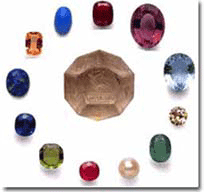 Gems & Astrology Every thing in this universe is composed of Seven Rays of colour. We can see these rays in Rainbow. On our planet Earth the greatest condensation of the cosmic rays is to be found in natural gem stones. A Gemstones Properly Harmonized with your Horoscope can create a miracle in your life. Similarly wearing wrong Gemstones unknowingly can have an adverse effect on you. Gems & Astrology Every thing in this universe is composed of Seven Rays of colour. We can see these rays in Rainbow. On our planet Earth the greatest condensation of the cosmic rays is to be found in natural gem stones. A Gemstones Properly Harmonized with your Horoscope can create a miracle in your life. Similarly wearing wrong Gemstones unknowingly can have an adverse effect on you.
| Zodiac Sign |
Ruling Planet |
Primary Gemstone(s) |
Secondary Gemstone(s) |
| Aries |
Mars |
Red coral, Garnet, Cornelian |
Blood Stone |
| Taurus |
Venus |
Diamond, White Zircon, White coral |
White Topaz, White Zircon |
| Gemini |
Mercury |
Emerald |
Green Jade, Peridot |
| Cancer |
Moon |
Pearl, Moonstone |
Moon Stone |
| Leo |
Sun |
Ruby, Star Ruby, Garnet |
Red Garnet, Red Tourmaline |
| Virgo |
Mercury |
Emerald |
Green Jade, Peridot |
| Libra |
Venus |
Diamond, White Zircon, White coral |
White Topaz, White Zircon |
| Scorpio |
Mars |
Red coral, Garnet, Cornelian |
Blood Stone |
| Sagittarius |
Jupiter |
Topaz, Yellow Sapphire |
Yellow Topaz, Citerine |
| Capricorn |
Saturn |
Blue Sapphire, Lapis Lazuli |
Amethyst |
| Aquarius |
Saturn |
Blue Sapphire, Lapis Lazuli |
Amethyst |
| Pisces |
Jupiter |
Topaz, Yellow Sapphire |
Yellow Topaz, Citerine |
| Moon’s North Node |
Rahu |
Hessonite Garnet or Gomed |
|
| Moon’s South Node |
Ketu |
Cat’s Eye or Lahsunia |
|
|
Sun and its Gemstone Ruby
 The Sun is the vital life force and represents the Soul. An individual who’s Sun is well placed in the birth chart can never be unsuccessful. He will always be in limelight whether as a Union Leader or a statesman. Ruby is the Gemstone that is used to enhance the powers of the Sun.For thousands of years, the ruby has been considered one of the most valuable gemstones on Earth. India is regarded as the ruby’s country of origin. In the major works of Indian literature, a rich store of knowledge about gemstones has been handed down over a period of more than two thousand years.
Ruby is the red variety of the mineral corundum, one of the hardest minerals on Earth, of which the sapphire is also a variety. On the Mohs scale their score of 9 is second only to the diamond. The term ‘corundum’, which we use today, is derived from the Sanskrit word ‘kuruvinda’ (Ruby). Another Sanskrit word for ruby is ‘ratnaraj’, which means something like ‘king of the gemstones’.
Pure corundum is colourless. Slight traces of elements such as chrome, iron, titanium or vanadium are responsible for the colour. Only red corundum is entitled to be called ruby, all other colours being classified as sapphires. The red colour is associates with love and vivacity, passion and power.
For a long time India was regarded as the ruby’s classical country of origin. In the major works of Indian literature, a rich store of knowledge about gemstones has been handed down over a period of more than two thousand years. The term ‘corundum’, which we use today, is derived from the Sanskrit word ‘kuruvinda’. The Sanskrit word for ruby is ‘ratnaraj’, which means something like ‘king of the gemstones’. Latin word ‘rubens’, meaning ‘red’.
Famous ruby deposits occur in Myanmar a rich, full red with a slightly bluish hue. Deposits also exist in neighbouring Vietnam, near the Chinese border. Rubies of Vietnamese origin generally display a slightly purplish hue. Rubies from Thailand, another classical supplier, however, often have a darker red which tends towards brown. This ‘Siamese colour’ – an elegantly muted deep red – is considered second in beauty only to the Burmese colour, and is especially popular in the USA. Ceylon (Sri Lanka) rubies, which have now become very rare, are mainly light red, like ripe raspberries. Other ruby deposits are located in Northern Pakistan in the Hunza Valley, Kashmir, Tadzhikistan, Laos, Nepal, and Afghanistan. Rubies are also produced in India, where deposits with relatively large crystals were discovered in the federal states of Mysore and Orissa. These crystals have many inclusions, but they are, nevertheless, eminently suited to being cut as beads or cabochons. Lately, Africa has also become a source of rubies, but usually the qualities mined there are of average quality.
The Sun is the vital life force and represents the Soul. An individual who’s Sun is well placed in the birth chart can never be unsuccessful. He will always be in limelight whether as a Union Leader or a statesman. Ruby is the Gemstone that is used to enhance the powers of the Sun.For thousands of years, the ruby has been considered one of the most valuable gemstones on Earth. India is regarded as the ruby’s country of origin. In the major works of Indian literature, a rich store of knowledge about gemstones has been handed down over a period of more than two thousand years.
Ruby is the red variety of the mineral corundum, one of the hardest minerals on Earth, of which the sapphire is also a variety. On the Mohs scale their score of 9 is second only to the diamond. The term ‘corundum’, which we use today, is derived from the Sanskrit word ‘kuruvinda’ (Ruby). Another Sanskrit word for ruby is ‘ratnaraj’, which means something like ‘king of the gemstones’.
Pure corundum is colourless. Slight traces of elements such as chrome, iron, titanium or vanadium are responsible for the colour. Only red corundum is entitled to be called ruby, all other colours being classified as sapphires. The red colour is associates with love and vivacity, passion and power.
For a long time India was regarded as the ruby’s classical country of origin. In the major works of Indian literature, a rich store of knowledge about gemstones has been handed down over a period of more than two thousand years. The term ‘corundum’, which we use today, is derived from the Sanskrit word ‘kuruvinda’. The Sanskrit word for ruby is ‘ratnaraj’, which means something like ‘king of the gemstones’. Latin word ‘rubens’, meaning ‘red’.
Famous ruby deposits occur in Myanmar a rich, full red with a slightly bluish hue. Deposits also exist in neighbouring Vietnam, near the Chinese border. Rubies of Vietnamese origin generally display a slightly purplish hue. Rubies from Thailand, another classical supplier, however, often have a darker red which tends towards brown. This ‘Siamese colour’ – an elegantly muted deep red – is considered second in beauty only to the Burmese colour, and is especially popular in the USA. Ceylon (Sri Lanka) rubies, which have now become very rare, are mainly light red, like ripe raspberries. Other ruby deposits are located in Northern Pakistan in the Hunza Valley, Kashmir, Tadzhikistan, Laos, Nepal, and Afghanistan. Rubies are also produced in India, where deposits with relatively large crystals were discovered in the federal states of Mysore and Orissa. These crystals have many inclusions, but they are, nevertheless, eminently suited to being cut as beads or cabochons. Lately, Africa has also become a source of rubies, but usually the qualities mined there are of average quality. |
The Moon and Its gemstone Pearl
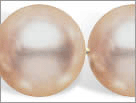
Moon is the presiding deity of the element water, and rules over the tides of the sea, rainwater, plants and the vegetable kingdom. Moon represents the mother or female. It is a sub-planet of earth taking light from the sun. The colour of Moon is white. Its nature is mucus dominated, tender hearted, wise and learned. It influences mind, comfort, general well being and also the fortune of a person. The gem stone related to Moon is Pearl.
The “Queen of Gems,” Pearls are known for over 6 thousand years and were praised very high in ancient Egypt. White in colour they come in various shades like blue, pink, golden, silver, green black and rainbow. Blue and pink Pearls are the most precious of all Pearls.
In the ancient Hindu holy texts, the pearls were also described in Atharvaveda, Garuda Purana etc. Ayurveda has references to pearl powder as a stimulant of digestion and to treat mental ailments. According to Marco Polo (1254 – 1325), the kings of Malabar (Coromandel Coast) wore a necklace of 104 rubies and 104 precious pearls.
The name pearl has come from the Latin pernula – a “sea shell”. Before the creation of cultured pearls in the early 1900s, natural pearls were rare and expensive and reserved almost exclusively for the noble and very rich. In several European languages, the word ‘pearl’ is synonymous with ‘bead’, which can lead to confusion when articles are translated.
The ideal pearl is perfectly round and smooth but many other shapes of pearls occur. It is formed within living shelled molluscs when calcium carbonate is deposited in concentric layers. The largest pearl known(6.4 kg), was found in the Philippines in 1934.
During the long history of pearls, the principal oyster beds lay in the Persian Gulf, along the coasts of India, Sri Lanka and in the Red Sea. Chinese pearls came mainly from freshwater, whereas Japanese pearls from salt water. Freshwater pearls were discovered in the Ohio, Mississippi, and Tennessee River basins. So many gems were exported to Europe in the 1800’s that the New World quickly gained the appellation “Land of Pearls”. Nowadays, Pearls are cultivated at the special plantations. Natural Pearls are produced in India, Ceylon, Tahiti, Iran and in the Red sea coast. Many pearls are artificially be dyed yellow, green, blue, brown, pink, purple, or black for ornamental use.
In 1914 in Japan, pearl farmers began growing cultured freshwater pearls. China has recently overtaken Japan in pearl production. Cultured pearls are less valuable than natural pearls, and imitation pearls are less valuable than cultured pearls.
Valid
XHTML and
CSS.
Mars and its Gemstone Red Coral
Mars’ average distance from the Sun is roughly 230 million km or 1.5 AU (an AU is the Astronomical Unit = approximately 150 million kilometer, the mean distance between the Earth and the Sun) and its orbital period is 687 (Earth) days. The solar day (or sol) on Mars is only slightly longer than an Earth day: 24 hours, 40 minutes.Mars is a masculine planet which radiates an intense and fiery energy. Mars governs soldiers and warfare, ambassadors and orators, restaurateur and cooks, athletes and pilots, real estate and construction. It rules the colour and the basic energy of life. The planet is named after the Roman god of war. It is also referred to as the “Red Planet” because of its reddish appearance which is due to iron oxide. In Indian Mythology Mars is the son of the earth. Mars often indicates a violent temper and destructive tendencies. Gemstones ruled by Mars include natural red coral, carnelian, and other pink to red ochre coloured gems.
Coral is one of the most attractive decorative materials. Like the pearls, corals are also organic jewellery products of the water, chemically closely related with each other and consist of more than 90 per cent calcium carbonate. Coral, it is said, relieves tension and fear and promotes positive forms of social life.
Corals live at depths of between 3 and 300 metres in the waters around Japan, Taiwan, the Malaysian Archipelago, the Red Sea, Bay of Biscay and around the Canary Islands, as well as in north-east Australia and the Midway Islands. In the Mediterranean, there are coral banks in the Tyrrhenian Sea, off the coast of Sardinia, Tunisia Algeria, former Yugoslavia and Turkey. When we hear the word coral we first think of the coral reefs of Australia or other beautiful protected coral reefs. But jewellery species are different. Corals polyps, surrounded by a fleshy skin, excrete a carbonic substance from which the corals grow like trees and branches. These can attain a height of 40 cm, though the actual branches seldom exceed 4 cm.
Traditionally, the fragile little coral trees were brought up from the depths with trawl nets. However, since first-class corals have now become rather rare, divers are now deployed, in a less destructive process going down and harvesting the sensitive coral branches. After that, the branches are cleaned, sorted and processed.
Unprocessed, coral is matt but after polish takes on beautiful shine. It is often porous, full of holes or cracked, and in these cases it is of lesser quality. Coral of such kind is sometimes filled with coloured wax to improve its appearance. Genuine untreated coral is rare. High-quality coral is of an even colour and free of cracks, blotches, striations and holes.
Corals range in colours from red to white and from blue and brown to black. The most popular are the red hues. Black corals and gold corals are very much in fashion, whilst the blue ones are extremely rare. The white of the angel skin coral, suffused with pink, is regarded as particularly precious.
On the one hand corals are not particularly sensitive, but with a hardness of only 3.5 they are much softer than any other gemstone material. Their beauty can easily be impaired by the wrong treatment, for example cosmetics, hot water or bright light. Coral jewellery should be kept in a safe place and from time to time cleaned with a soft, damp towel. If the surface of the coral does get scratched, the jeweller can have it re-polished. |
Valid
XHTML and
CSS.
Mercury and Its Gemstone Emerald
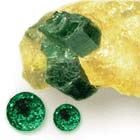
Gem-Mercury Emerald
Jupiter and Its Gemstone Yellow Sapphire
Jupiter is the largest and heaviest planet in the solar system and the teacher (Guru) of Gods; Jupiter is given the ministership among the assembly of nine planets. The Jupiter is a sattvik and benefitting planet, significator of luck and fortune. The colour of the Jupiter is yellow. Thursday is his days and northeast is his direction. The gemstone related to Jupiter is-the yellow sapphire which is most beneficial to the natives of the Sagittarius and Pisces signs of the zodiac.
Yellow sapphire is a mineral. After analyzing chemically it is proved that aluminium, hydrovisil and florin are present in it. It is found in the Himalayas, Ceylon and Russia. It is weighty, smooth, transparent, and found in many colours – white, light and deep yellow and light orange.
The yellow sapphire is regarded as the best of gems in the same way as Brihaspati is the teacher of gods. Brihaspati (Jupiter) represents wisdom, religion in human life. Therefore it is such a gem which is worthy to be worn by all. The wearer of yellow sapphire gets the knowledge of law, ethics, wit, wisdom, pleasure of getting issues, worldly happiness, Para physical bliss, physical power, cleverness, long life, good health, food grains, prosperity glory and mental peace. It is the most beneficial to the authors, writers, barristers, traders and businessmen.
The girls in the family who have reached the age of marriage should wear the yellow sapphire because it removes the delay in their way of marriage. However a spouse (husband or wife) should wear for a happier conjugal life. It helps to pacify the anger of its wearer by providing sharp sightedness. It strengthens the bondage of friendship. It shows its influence by removing the danger of accidental death.
A ring worn in this manner brings good luck, peace and prosperity. The Yellow Sapphire (Pukhraj) bestows vigor, vitality, wisdom, longevity, name and fame. If someone is having problems in finding a good mate for his daughter that problem will also be solved. One who wears Yellow Sapphire (Pukhraj) progresses in the spiritual field and becomes free from all the fears of evil vibrations, ghosts and genii. It is also well-recognised concept that it is beneficial to the patients suffering form fever, cough, rheumatism, mouth’s foul smell, and kidney disease.
Jupiter is the largest, most auspicious and beneficent planet. Wealthy and influential individuals generally possess a strong Jupiter in their horoscopes, and this reflects the rich rewards of positive karma accumulated in previous lives. Jupiter governs religious activity, financial affairs, personal happiness, and teaching. Jupiter also determines one’s spiritual orientation. It is associated with the color yellow, the bodily fluids, education, pilgrimage places, and transcendental wisdom. The Sanskrit name for Jupiter is “guru,” indicating a source of divine knowledge and spiritual insight.
If Jupiter is exalted one will be a leader of men, powerful, respected, although susceptible to anger. But if the position of Jupiter in a person’s horoscope is debilitated Jupiter can cause personal unhappiness, egotism, sloth, and legal problems. LIGHT BLUE is the cosmic color transmitted by yellow sapphires and other yellow gems. Light blue color waves, being very cold, relate to the ethereal nature and are helpful in curing diseases of the glands, the fat system and bodily cavities. Jupiter astral talismans are known to enhance spiritual understanding, facilitate pregnancy and childbirth, improve marital relations, increase one’s fortune, and help balance the endocrine system. Jupiter jewels are known to be especially favorable to women by enhancing their happiness and contentment.
Gemstones Jupiter’s energy is transmitted by natural yellow sapphires, topaz, citrine, heliodor, and other flawless (eye-clean) yellow gems.
Venus and Its Gemstone Diamond
Venus (Shukra) is the brightest planet only after the sun and the moon in the sky. It is the second-closest planet to the Sun, orbiting it every 224.7 Earth days. it is sometimes called Earth’s “sister planet,” because the two are similar in size. Venus or Shukra is the teacher of demons.It is to be said that Lord Shiva imparted the knowledge of making the dead alive (Mrityusanjivini Vidya) to Shukra. Venus (Shukra) is also important because of its association with the science of mantras and medicine, tantra, the casting of spells, hypnotism, mesmerism and alchemy. Venus is known as Aphrodite in Greek Mythology and also as the Roman Goddess of femininity beauty, attraction, art and Love. The gem stone of Venus is the diamond.
Diamond, the king of gem abounds in chemical values and it is the most precious mineral. It is famous for its surprising lustre hardness and beauty. Diamonds are made of pure carbon.
Diamonds were first discovered in India. The Arthshashastra of Kautilya (Chanakya/Vishnugupta, 350-283 BC) mentions diamond trade in India. India’s diamonds were prized for their size and beauty for hundreds of years. “Indian” diamonds were mined in numerous locations that included Golconda (in the present-day state of Andhra Pradesh). The most famous Giaconda stones include the Hope Diamond, Kohinoor Diamond, Orlov Diamond, and Sanc Diamond. The Darya-ye-Nur (Sea of Light) was a rare blue-diamond weighed 186 carats, which was owned by the Nadir Shah of Persia after it was plundered from the last ‘Great Mughal Emperor,’ Aurangzeb’s heir (Mohammad shah) in the ‘sack of Delhi’ in 1739, and which presently forms part of the Iranian Crown Jewels. Kohinoor was re-cut during the reign of Queen Victoria. It now weighs 108 carats and forms part of the British Crown Jewels.
Most of India’s diamond mines were depleted centuries ago and the India’s only remaining diamond source is a mine at Panna in the state of Madhya Pradesh. Most of the diamonds entering Europe originated in India. In the later half of the 14th century the diamond trade reached to Belgium. Today, some 85% of the world’s rough diamonds, 50% of cut diamonds, and 40% of industrial diamonds are traded in Antwerp, Belgium.
South Africa became the biggest producer after discovery of diamonds there in 1866. De Beers Diamond Company was founded there 1888 which later popularised the use of diamonds in engagement rings.
Diamond’s weight is measured in carat (200 milligrams). The point unit, equal to one one-hundredth of a carat, is commonly used for diamonds of less than one carat.
The finest quality as per colour grading is totally colourless. However, in reality almost no gem-sized natural diamonds are absolutely perfect. The colour of a diamond may be affected by chemical impurities and/or structural defects.
Most diamonds used as gemstones are basically transparent with little tint, or white diamonds. Most white diamonds are discounted in price as more yellow hue is detectable, while intense pink or blue diamonds can be dramatically more valuable.
Artificial diamonds, while chemically identical to mined diamonds, are created by engineers in a laboratory whereas cubic zirconium, glass, or quartz resembles diamonds. Alternative names such as cultured, grown, laboratory, or man-made diamonds, are also in use. |
The Saturn and Its gemstone Blue Sapphire
Saturn is the sixth planet (9AU) from the Sun and the second largest planet, after Jupiter. It takes about 29½ Earth years to finish one revolution around the Sun. shani(Son of Sun) or Saturn represents longevity, discipline, authority, ambition, leadership, honesty, perfection, humility, elders, denial, delays, misery, adversity, accidents, conservatism and dutifulness. Its role is often symbolized as a servant. Its influence is often seen as restrictive or obstructive yet its influence also seeks to bring balance. Blue Sapphire is the Gemstone that is used to enhance the powers of the Sun.
This magnificent gemstone comes in many other colours: not only in the transparent greyish-blue but also – in yellow, pink, orange and purple. Sapphires are easy to look after, requiring no more than the usual care on the part of the wearer. Blue is the main colour of the sapphire. We associate this colour with feelings of sympathy and harmony, friendship and loyalty, mutual understanding and indestructible trust. That is one of the reasons why women in many countries wish for a sapphire ring on their engagement.
The gemstones in the corundum group consist of pure aluminium oxide which crystallised into wonderful gemstones characterised by their excellent hardness (9 on the Mohs scale). The presence of small amounts of other elements, especially iron and chrome, are responsible for the colouring. However, this does not mean that every corundum is also a sapphire. For centuries there were differences of opinion among the specialists as to which stones deserved to be called sapphires. Finally, it was agreed that the ruby-red ones, coloured by chrome, should be called ‘rubies’ and all those which were not ruby-red ‘sapphires’.
Sapphires are found in India, Burma, Ceylon, Thailand, Vietnam, Australia, Brazil and Africa. The oldest sapphire finds are in Sri Lanka. There, people were already digging for gemstones in ancient times. Presently, most blue sapphires come either from Australia or from Thailand. Top-quality sapphires are rare. The most valuable are genuine Kashmir stones. Burmese sapphires are valued almost as highly, and then the sapphires from Sri Lanka.
Large gemstone deposit was found in Madagascar a few years ago. Since then, not only have there been enough blue sapphires in the trade, but also some splendid pink and yellow sapphires of great beauty and transparency. Meanwhile, Tanzania have also found initial evidence of two gemstone deposits of sapphire crystals coloured blue, green, yellow and orange. And the third country to register new finds recently was Brazil, where sapphires ranging from blue to purple and pink have been discovered.
Shadow Planet Rahu and Its gemstone Garnet
Hindu astronomers, from the time of Gupta (about 300 A.D.), understood that eclipses were caused by the shadows of the Earth or Moon. The apparent path that the Sun traces out in the sky during the year is called the ecliptic. All planets do not revolve around sun in a same plane. The orbit of the Moon is inclined by about 5° on the ecliptic. The Moon moves around the entire sky in the course of about 27 days, and its path crosses the ecliptic in two places every month. These places are called nodes. When moon is moving towards north, the node is called ascending Node or Rahu, while the other node which is 180 degrees south is called the descending node which moon crosses roughly 14 days later while going back towards south. When such crossing occurs during new moon or full moon, eclipse takes place. Its nodal points are not fixed either, and regresses (moves towards the west) over a full circle (360 degrees) every 18.6 years
According to legend, during the demon Rahu drank some of the divine nectar. It was detected by the sun and the moon, but before the nectar could pass his throat, Mohini (the female avatar of God Vishnu) cut off his head. The head (Rahu), and the body (Ketu) however, remained immortal. It is believed that Rahu occasionally swallow the sun or the moon, causing eclipses. When, the sun or moon passes through the opening at the neck, the eclipse ends.
Rahu is a legendary master of deception. It signifies cheats, pleasure seekers, insincere an immoral acts, operators in foreign land, drug dealer, poison dealers etc. Rahu is the significator of Faulty Logic, Harsh speech, Outcaste, an irreligious person, going to a foreign country, Unclean, Bones, abdominal ulcers, Falsehood. Rahu is instrumental in strengthening ones power and converting even an enemy into a friend. The gemstone of Rahu is (Hessonite) Garnet.
The garnet group includes a group of minerals that have been used since the Bronze Age (3300 BC to1200 BC) as gemstones and abrasives. Six common species (e.g. Hessonite) of garnet are recognized based on their chemical composition. Hessonite or Cinnamon Stone is a calcium aluminum mineral of the garnet group with the general formula Ca3Al2Si3O12. It has a characteristic red color, inclining to orange, much like that of gem zircon. The specific gravity of hessonite is 3.64 to 3.69, whilst that of zircon is about 4.6. Hessonite has a similar hardness to that of quartz, about 7 on the mohs scale, whilst the hardness of some other garnet species can reach 7.5.
Hessonite comes chiefly from Sri Lanka. It is also found in Brazil and California. |
Shadow Planet Ketu and Its gemstone Cat’s Eye
Ketu is also a half-planet that bestows wisdom, powers of discrimination, and gyana – spiritual knowledge, the knowledge of the self. It gives psychic abilities to its natives and makes them masters of the healing arts, natural healing, healing herbs, spices, foods, tantric healing, healing of persons possessed by evil spirits, ghosts and astral forces.
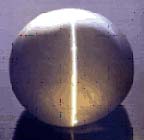
Cat’s Eye
.
 The Sun is the vital life force and represents the Soul. An individual who’s Sun is well placed in the birth chart can never be unsuccessful. He will always be in limelight whether as a Union Leader or a statesman. Ruby is the Gemstone that is used to enhance the powers of the Sun.For thousands of years, the ruby has been considered one of the most valuable gemstones on Earth. India is regarded as the ruby’s country of origin. In the major works of Indian literature, a rich store of knowledge about gemstones has been handed down over a period of more than two thousand years.
Ruby is the red variety of the mineral corundum, one of the hardest minerals on Earth, of which the sapphire is also a variety. On the Mohs scale their score of 9 is second only to the diamond. The term ‘corundum’, which we use today, is derived from the Sanskrit word ‘kuruvinda’ (Ruby). Another Sanskrit word for ruby is ‘ratnaraj’, which means something like ‘king of the gemstones’.
Pure corundum is colourless. Slight traces of elements such as chrome, iron, titanium or vanadium are responsible for the colour. Only red corundum is entitled to be called ruby, all other colours being classified as sapphires. The red colour is associates with love and vivacity, passion and power.
For a long time India was regarded as the ruby’s classical country of origin. In the major works of Indian literature, a rich store of knowledge about gemstones has been handed down over a period of more than two thousand years. The term ‘corundum’, which we use today, is derived from the Sanskrit word ‘kuruvinda’. The Sanskrit word for ruby is ‘ratnaraj’, which means something like ‘king of the gemstones’. Latin word ‘rubens’, meaning ‘red’.
Famous ruby deposits occur in Myanmar a rich, full red with a slightly bluish hue. Deposits also exist in neighbouring Vietnam, near the Chinese border. Rubies of Vietnamese origin generally display a slightly purplish hue. Rubies from Thailand, another classical supplier, however, often have a darker red which tends towards brown. This ‘Siamese colour’ – an elegantly muted deep red – is considered second in beauty only to the Burmese colour, and is especially popular in the USA. Ceylon (Sri Lanka) rubies, which have now become very rare, are mainly light red, like ripe raspberries. Other ruby deposits are located in Northern Pakistan in the Hunza Valley, Kashmir, Tadzhikistan, Laos, Nepal, and Afghanistan. Rubies are also produced in India, where deposits with relatively large crystals were discovered in the federal states of Mysore and Orissa. These crystals have many inclusions, but they are, nevertheless, eminently suited to being cut as beads or cabochons. Lately, Africa has also become a source of rubies, but usually the qualities mined there are of average quality.
The Sun is the vital life force and represents the Soul. An individual who’s Sun is well placed in the birth chart can never be unsuccessful. He will always be in limelight whether as a Union Leader or a statesman. Ruby is the Gemstone that is used to enhance the powers of the Sun.For thousands of years, the ruby has been considered one of the most valuable gemstones on Earth. India is regarded as the ruby’s country of origin. In the major works of Indian literature, a rich store of knowledge about gemstones has been handed down over a period of more than two thousand years.
Ruby is the red variety of the mineral corundum, one of the hardest minerals on Earth, of which the sapphire is also a variety. On the Mohs scale their score of 9 is second only to the diamond. The term ‘corundum’, which we use today, is derived from the Sanskrit word ‘kuruvinda’ (Ruby). Another Sanskrit word for ruby is ‘ratnaraj’, which means something like ‘king of the gemstones’.
Pure corundum is colourless. Slight traces of elements such as chrome, iron, titanium or vanadium are responsible for the colour. Only red corundum is entitled to be called ruby, all other colours being classified as sapphires. The red colour is associates with love and vivacity, passion and power.
For a long time India was regarded as the ruby’s classical country of origin. In the major works of Indian literature, a rich store of knowledge about gemstones has been handed down over a period of more than two thousand years. The term ‘corundum’, which we use today, is derived from the Sanskrit word ‘kuruvinda’. The Sanskrit word for ruby is ‘ratnaraj’, which means something like ‘king of the gemstones’. Latin word ‘rubens’, meaning ‘red’.
Famous ruby deposits occur in Myanmar a rich, full red with a slightly bluish hue. Deposits also exist in neighbouring Vietnam, near the Chinese border. Rubies of Vietnamese origin generally display a slightly purplish hue. Rubies from Thailand, another classical supplier, however, often have a darker red which tends towards brown. This ‘Siamese colour’ – an elegantly muted deep red – is considered second in beauty only to the Burmese colour, and is especially popular in the USA. Ceylon (Sri Lanka) rubies, which have now become very rare, are mainly light red, like ripe raspberries. Other ruby deposits are located in Northern Pakistan in the Hunza Valley, Kashmir, Tadzhikistan, Laos, Nepal, and Afghanistan. Rubies are also produced in India, where deposits with relatively large crystals were discovered in the federal states of Mysore and Orissa. These crystals have many inclusions, but they are, nevertheless, eminently suited to being cut as beads or cabochons. Lately, Africa has also become a source of rubies, but usually the qualities mined there are of average quality.
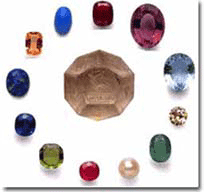




Recent Comments